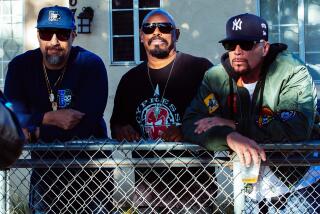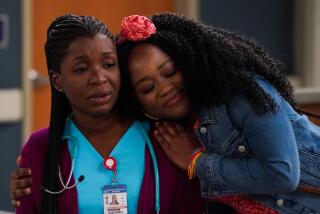TELEVISION : Mr. Rogers’ Heroes Are in Your Neighborhood
- Share via
“Are you anybody?”
That’s the question you repeatedly hear from kids who mass in the vicinity of the Emmys, Oscars and other glittery events that draw celebrities. Even if you’re just passing by, these pursuers of luminaries come at you like beggars seeking handouts.
If you fib and say you are “somebody,” autograph books are thrust at you and you’re implored to sign. Just what VIP groupies do with the autographs of genuine celebrities is a puzzle. Do they frame them? Carry them around to show their friends? Trade them like baseball cards? File them away and them take them out periodically to reminisce, the way you do with photo albums? Do they keep them on display and ogle and touch them? Do they worship them? Dance around them? Sniff them? Run their hands through them like a miser does gold coins? The attraction mystifies.
There’s nothing new in this. The famous and powerful were probably getting the same attention from autograph paparazzi as far back as ancient Rome.
“Would you sign my goat skin?”
“Sure, kid.”
Best wishes, Caligula.
*
Far too often, public figures are worshiped for wrong or insufficient reasons--a message emphatically delivered in “Baseball,” the new Ken Burns documentary series coming to PBS Sept. 18. “I was just heartbroken,” says a 90-year-old man, recalling the national shock over revelations that gamblers had bribed key members of the Chicago White Sox to throw the 1919 World Series in what came to be known as the Black Sox Scandal.
The most famous of the eight perpetrators was an illiterate named “Shoeless” Joe Jackson, a hitting star who had become the icon of schoolboys everywhere. That Jackson and his teammates had ever been granted hero status due to their glories on the field was an even bigger scandal.
Yet such misplaced worship of sports figures is hardly out of the ordinary in the United States and elsewhere.
Flash forward to 1994 and the “national hero” brand given O.J. Simpson in media accounts of the murders of his ex-wife, Nicole Brown Simpson, and Ronald Lyle Goldman. No one could recall when a “national hero” had been indicted for murder in the United States.
Just how football prowess, a bankable nickname, moderate celebrity as an actor and a soft-spoken public demeanor earned Simpson idolhood--or why he had become a role model for so many who knew him only from his public persona--was not initially questioned by those covering the double-homicide case.
As it turned out, the emperor was wearing only a few threads. Stripping away the thick glaze of imagery, Simpson was merely a former great athlete and reputed good guy (before reports of “911” calls and wife abuse surfaced), hardly traits that should have earned him a pedestal.
*
Yet in some media circles he was repeatedly ranked with those comic book champions that Fred Rogers (of “Mister Rogers’ Neighborhood’) describes on PBS this week--the ones from his childhood who “wore capes, flew through the air and picked up buildings with one arm.”
As he notes on his uplifting prime-time program, “Fred Rogers’ Heroes: Who’s Helping America’s Children,” the 66-year-old Rogers now has a loftier set of heroes: “People who confirm our best dreams about being human.” The hour profiles four of them, none of whom wear a cape.
In one of Chicago’s toughest neighborhoods, former high school dropout Olomenji O’Connor heads Project Peace, a program that teaches school kids to resolve problems non violently through peer mediation. It’s no easy task in this environment. When Olomenji asks a classroom of students how many come from families where someone has been shot, almost all hands go up.
In Brewster, N.Y., Dr. Sam Ross operates Green Chimneys, a year-round residential program of mutual healing at a working farm. In this Upstate New York locale, emotionally and psychologically troubled children interact with sick and injured animals. These kids, many of whom have been poorly nurtured themselves, become the nurturers of animals. “Sometimes I talk to them and tell them that I’m mad,” says a boy about his beloved pigeons.
The least effective segment profiles Glojean Todacheene, a Native American principal at Mesa Elementary School on the Navajo Reservation in Shiprock, N.M. Although demonstrating her compassion for students, the segment never clearly defines the “everlasting gift” it says she possesses as a school administrator.
Best of the hour is a segment featuring Carola de la Rocha, who as an aspiring dancer in her 20s left her East Los Angeles home and headed for Mexico City. She was accepted there into the Ballet Folklorico de Amalia Hernandez, ultimately becoming a soloist with the famed touring company.
*
De la Rocha (we also meet two of her top students) is an especially inspired choice for the program, departing from the more typical adult-helping-kids-with-problems theme. According to this profile by Los Angeles filmmaker Jean Victor, De la Rocha later returned to her roots, founding the Los Angeles Mexican Dance Company in Lincoln Heights in 1988. Her studio is now in downtown Los Angeles, and she turns away no one for lack of money.
Rogers’ own Family Communications produced “Heroes,” and he is both its narrator and principal interviewer, surfacing awkwardly, at times, to the detriment of the program. At the very least, though, this gentle hour focuses on those who have earned the hero label through their actions on behalf of others, rather than through their fame.
“I think there is a generous current in the American spirit,” Rogers said by phone last week. If so, it’s a current too rarely tapped by the media, especially newscasts and other television programs that obsessively feed and exploit public fear.
“There has been so much that’s negative in the media,” Rogers said. “So many people read and hear it, then turn to despair. I just wanted to show the many people who are really helping.”
That, in itself, is rather heroic.
* “Fred Rogers’ Heroes: Who’s Helping America’s Children” airs at 8 p.m. Tuesday on KCET-TV Channel 28, and at 8 p.m. Wednesday on KOCE-TV Channel 50 and KVCR-TV Channel 24.
More to Read
The complete guide to home viewing
Get Screen Gab for everything about the TV shows and streaming movies everyone’s talking about.
You may occasionally receive promotional content from the Los Angeles Times.






